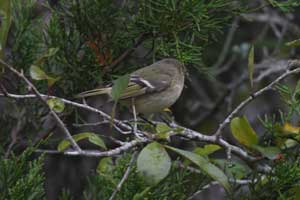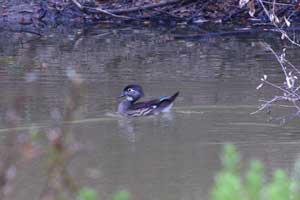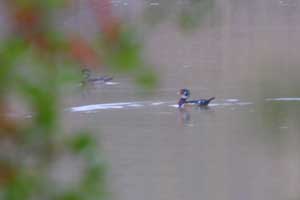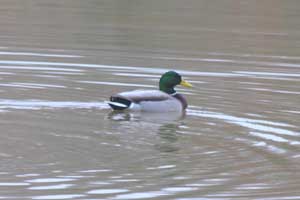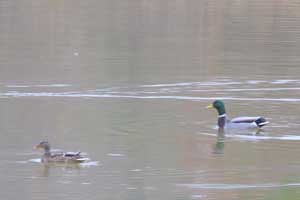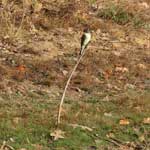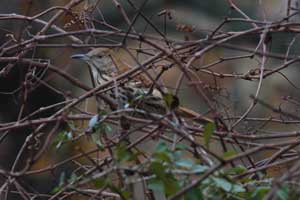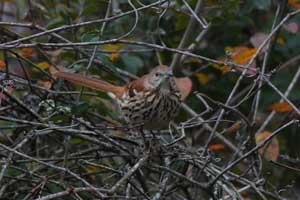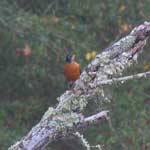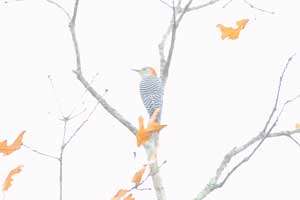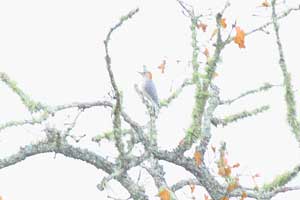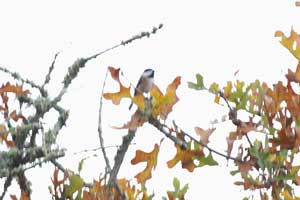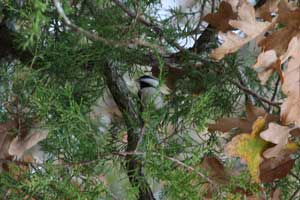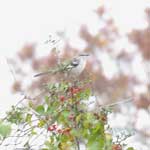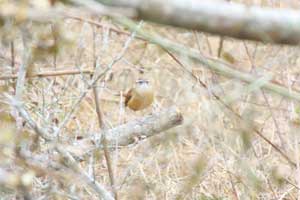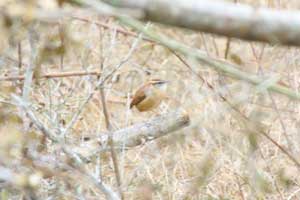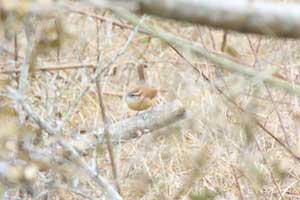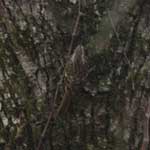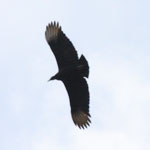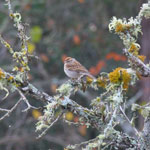Bird Count on Sula-Richards Farm, November 29, 2008 | |||||||||||||||
IntroductionPart of our 2008 Wildlife Management Plan includes doing a bird count for the farm. On November 29, 2008, I spent the day trying to identify as many species of birds as I could. My hope was to document my sightings as much as possible with photographs and, as it turned out, this proved to be an invaluable aide to identification. Not infrequently, I was able to accurately identify a bird only after examining the photograph that I had taken from a significant distance. The quality of digital cameras these days is quite wonderful. With the resolution of my Canon 40D Digital SLR camera, I was able to zoom in on the photography and identify birds that were complete mysteries to me when encountered in the field. My routine during the day was to walk out from the cabin for an hour or two (or until I had filled up the memory on my camera), then return to the cabin to analyze the photographs. I would copy the digital photographs to my laptop, then zoom in on the bird's image for details. I used three books to aid in identification: The Sibley Guide to Birds, by David Allen Sibley; Birds of North America, by Kenn Kaufman; and A Field Guide to the Birds of Texas, by Roger Tory Peterson. Having multiple books was more helpful than one might think. I know some people swear by Sibley, but the Peterson and Kaufman guides were very useful. For future bird counts, I hope to have some friends and relatives assist us. But in this, our first bird count, all observations were made by Joni and me; all photographs on this page were taken by me. I saw a total of 19 identifiable species during this day of birding. Here's the list: 1. American Crow (Corvus brachyrhynchos)The first thing I heard as I walked out of the cabin to start the day of birding was the raspy caw caw caw of crows in the distance. On the farm, they prove to be rather skittish. I heard them frequently throughout the day, and often saw them flying in the distance, but they would not tolerate my approach on foot. 2. Ruby-crowned Kinglet (Regulus calendula)
Later in the day, I was able to obtain a photograph of one of these hyperactive little birds. They aren't shy at all, and quite frequently will perch in branches just three or four feet away from me (sometimes too close to focus with a telephoto lens!). This is not a particularly good photograph, as the kinglet's head is turned away; but it was the only photograph I had from the day of the bird count. 3. Wood Duck (Aix sponsa)The Wood Ducks that frequent Turtle Pond during the winter are extremely shy. But I have learned to approach the pond as quietly as possible; sometimes you can get a photograph of the Wood Ducks before they become aware of you. Such was the case today.
4. Great Blue Heron (Ardea herodias)A Great Blue Heron was standing at the edge of the pond but flew away before I could get a photograph. 5. Mallard (Anas platyrhynchos)A pair of Mallards were on the pond, being somewhat romantic at times.
6. Northern Cardinal (Cardinalis cardinalis)The Northern Cardinal is probably the most frequently and easily identifable bird on the farm. Amazingly, I went the entire day neglecting to get a photograph. 7. Eastern Phoebe (Sayornis phoebe)
I saw an Eastern Phoebe on my first walk down to the pond on this day of the bird count. I didn't get a photograph on that walk, but I was successful later in the day, in virtually the same spot. Again, it's not a very good photograph; the phoebe was across the pond, and rather far away for my 100-300 mm lens. However, the photography done on this day was primarily for documentation of the bird count. So, it serves its purpose here. A lot of the birds in the flycatcher family look similar. I didn't want to wrongly identify any species, particularly since my intention was to put the list on the web. I spent a lot of time poring over the illustrations and photographs in my field guides. I also consulted an expert: a thank you here goes to my sister, Emily, who helped confirmed the identification of the Eastern Phoebe in this rather fuzzy photograph. 8. Brown Thrasher (Toxostoma rufum)This Brown Thrasher was hiding in a tangle of branches and vines close to the pond. Upon first look, I mistakenly identified it as a Wood Thrush. Luckily, I was close enough to snap off a dozen or so photographs. At a later time, while examining the photographs I realized that the tail of this bird was too long to be a thrush. It was definitely a thrasher, but I was unsure whether it was the Brown Thrasher or the Long-billed Thrasher. I emailed two expert birders--my sister, Emily, and my friend, Ananda--and they helped me identify it as a Brown Thrasher. (Photography and email are wonderful things!) The two best photographs are below:
9. American Robin (Turdus migratorius)
There's not a lot of resolution to this photograph; I was pretty far away and the photograph has been cropped significantly. But if you zoom in on the eye of the robin, you will see the distinctive white eye ring that the American Robin possesses. 10. Red-bellied Woodpecker (Melanerpes carolinus)I had seen what I thought was a Red-bellied Woodpecker on my first early walk out this morning; however, it wasn't until mid-morning that I finally managed to get some photographs. The photographs are not good at all; somehow I had not noticed that my camera was in manual mode, so the metering was off and my photographs were way overexposed. But the photograph is sufficient to show that it is the Red-bellied Woodpecker.
11. Blue Jay (Cyanocitta cristata)The Blue Jay is another commonly seen bird on the farm of which I have no picture. I saw them and heard them on my late morning walk, but never got close enough to photograph. 12. Turkey Vulture (Cathartes aura)I sighted some Turkey Vultures high in the sky circling, but didn't get a photograph. 13. Carolina Chickadee (Poecile carolinensis)I had several sightings of the Carolina Chickadee, but only managed a couple of very weak photographs, but sufficient for identification.
14. Northern Mockingbird (Mimus polyglottos)
Interestingly enough, when I do see mockingbirds, I often see them either perched atop a Yaupon Holly tree, as was this one, or hiding in its branches. This is another rather poor photograph--washed out and cropped so much that it has little resolution; but the only photograph I have of this day's sighting. Again, this one is placed here to provide as much documentation of the day's bird count as possible. 15. Carolina Wren (Thryothorus ludovicianus)Joni and I walked out to the Hi-Fi Pasture late morning and saw this Carolina Wren hiding out in one of the brush piles that we had created. That was sort of satisfying, since the very purpose of hauling all those trimmings and branches out to the Hi-Fi Pasture was to provide an attractive spot for birds and small mammals.
16. Brown Creeper (Certhia americana)
Once I spotted it, I took approximately 50 pictures, but none of them were very good: the Brown Creeper was pretty far away, buried under foliage and shadows. This bird photography can sure cause one to lust for bigger lenses! Both times that I've seen the Brown Creeper, its behavior has been the same, and just as described in the field guides: it starts at the lower part of a tree and slowly makes its way up, and then flies to the base of a different tree and starts again. 17. Black Vulture (Coragyps atratus)
The vulture was wheeling above the trees and I began snapping pictures. Although the vulture was partially obscured by trees in many of the shots, I was able to get one photograph in a clear patch of sky. I've cropped the photograph pretty significantly; hence, the poor resolution. However, it is quite identifiable as a Black Vulture. I never have quite decided which type of vulture seems prevalent on the farm. I see both the Black Vulture and the Turkey Vulture on almost any significant walk I take. Perhaps someday, I'll do a count to try to come up with an answer to that question. 18. Chipping Sparrow (Spizella passerina)
Some of the identification points that Emily and Ananda pointed out to me included the dark eye line and the bill color. I've looked at the Sibley, Peterson, and Kaufman field guides, and have come to see what they found convincing identification points. So, it's a Chipping Sparrow. 19. Pileated Woodpecker (Dryocupus pileatus)It was almost night, and not enough light left for any kind of photography. But yesterday, I had seen a Pileated Woodpecker on an electrical line pole at the north end of the Hi-Fi Pasture. There had been a large cavity in the pole, the kind that the Pileated makes. So Joni and I decided to walk there and see if we could get one final bird for our count. And sure enough, as we approached the pole, I saw the silouette of a crested head emerge from the hole, turn our way, and then a Pileated Woodpecker climbed out of the cavity and flew away. It made for a nice way to end the day and the bird count. | |||||||||||||||
Contact Info
© 2015 Earl Richards. All rights reserved.
